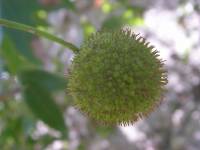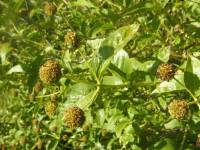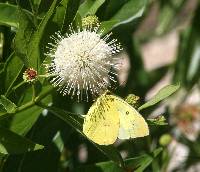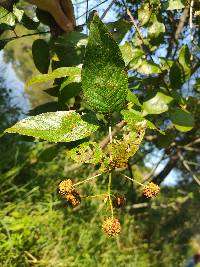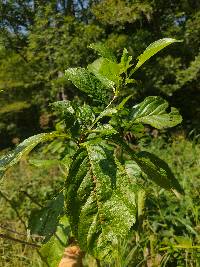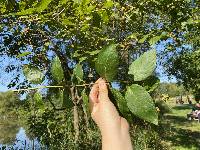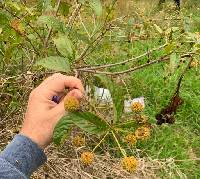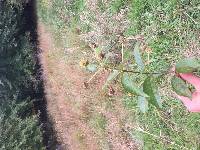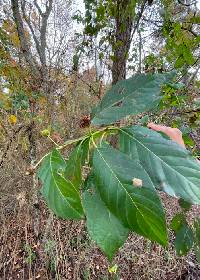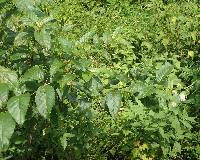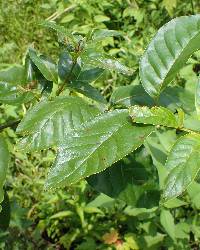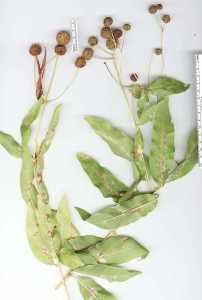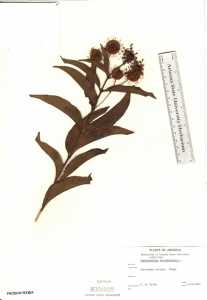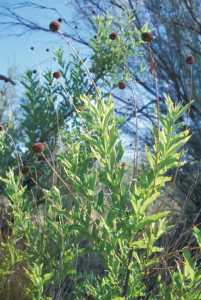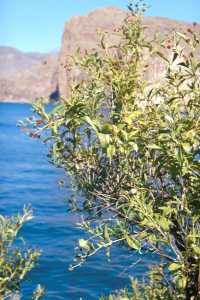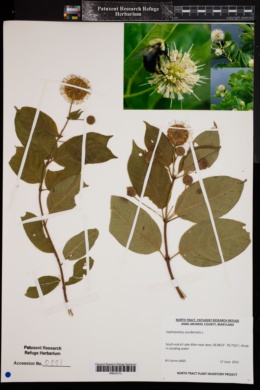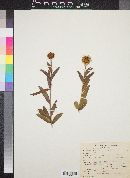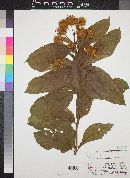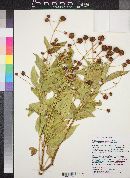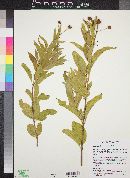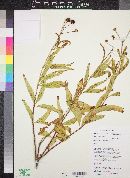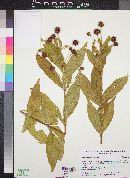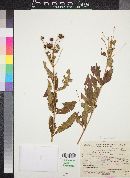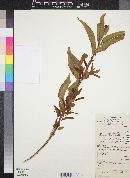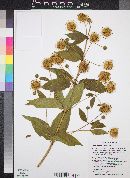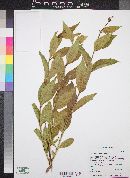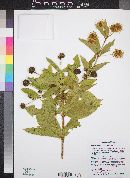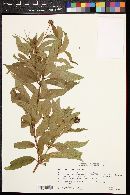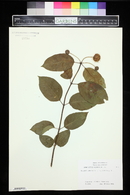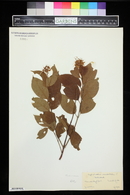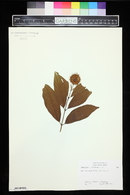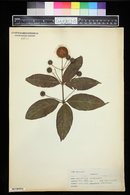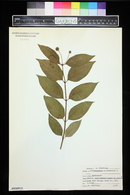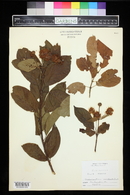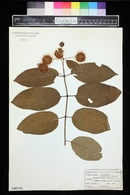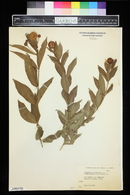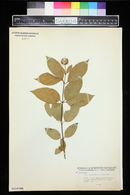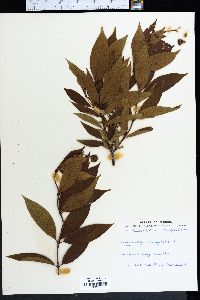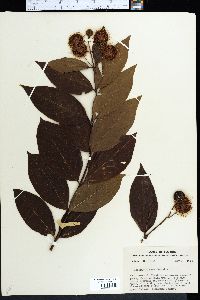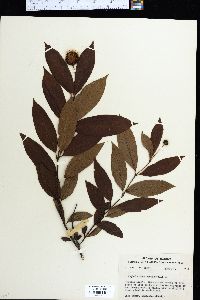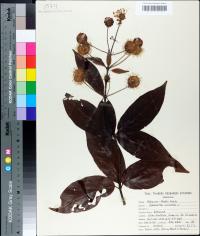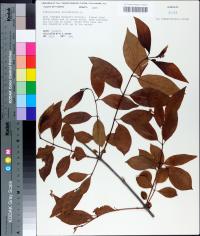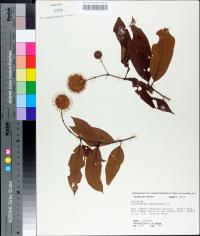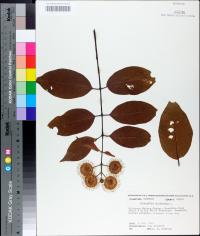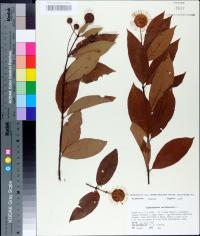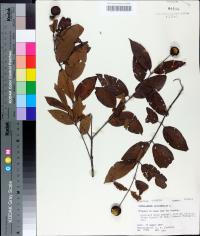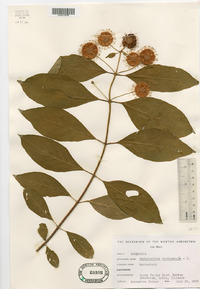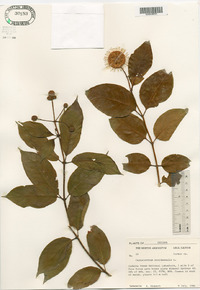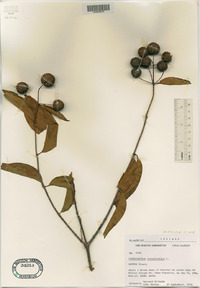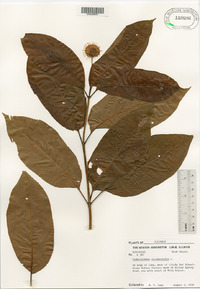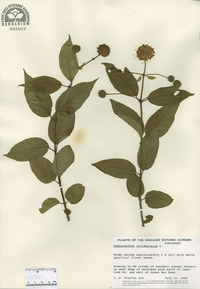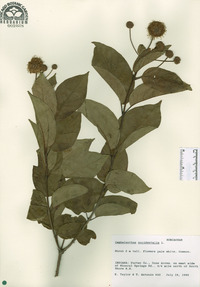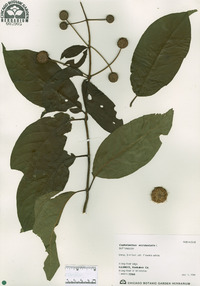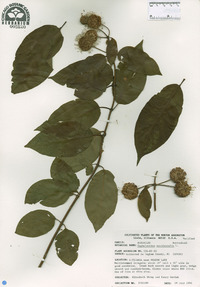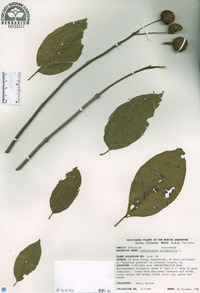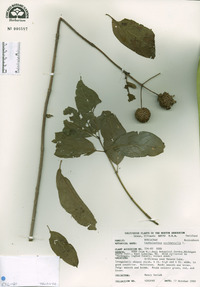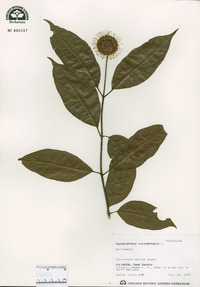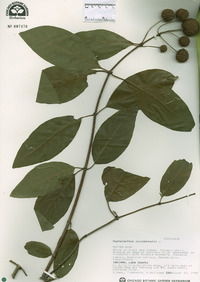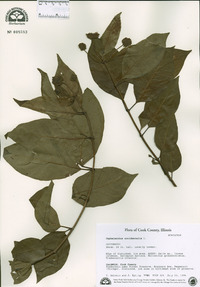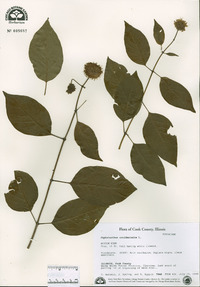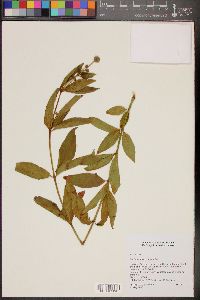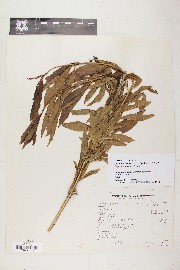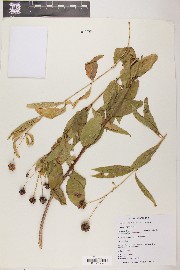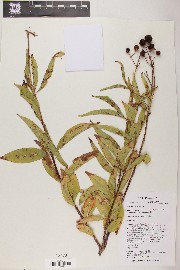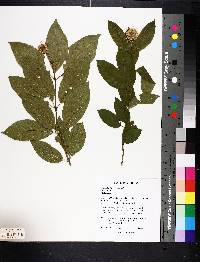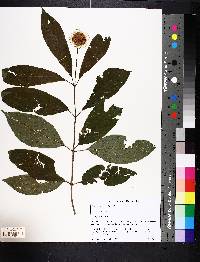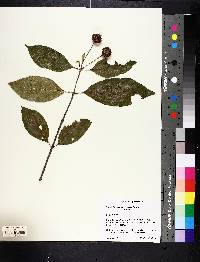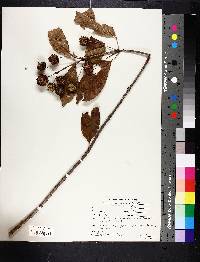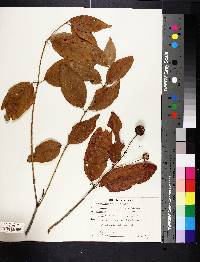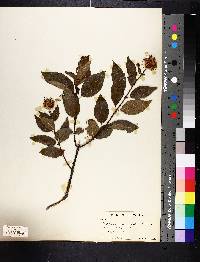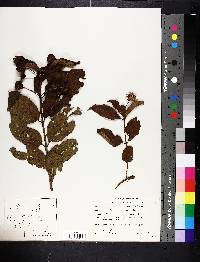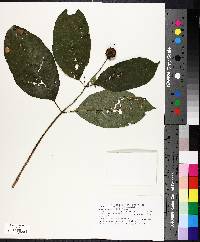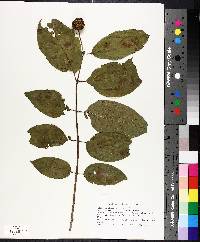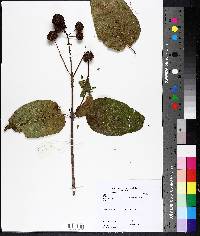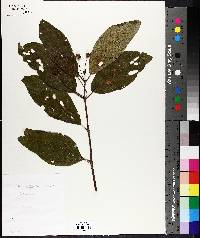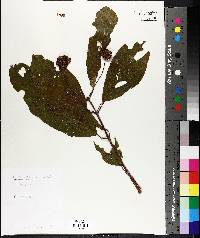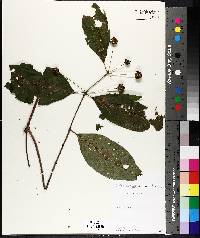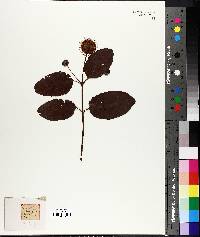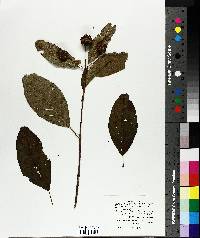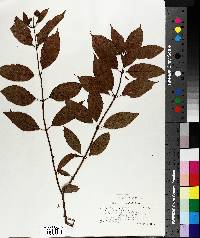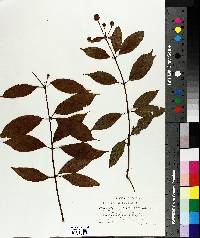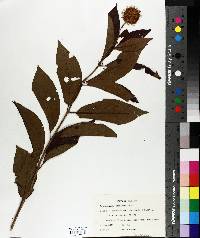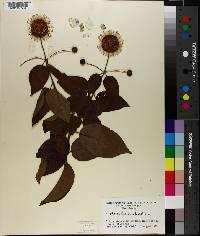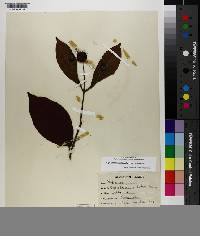
|
|
|
|
Family: Rubiaceae
Common Buttonbush, more...button-bush, buttonbush (es: mimbre, mimbro)
[Cephalanthus occidentalis f. lanceolatus Fernald, moreCephalanthus occidentalis subsp. californicus (Benth.) A.E.Murray, Cephalanthus occidentalis var. brachypodus DC., Cephalanthus occidentalis var. californicus Benth., Cephalanthus occidentalis var. pubescens Raf., Cephalanthus pubescens] |
Plant: shrub or tree; 2-7(-10) m high, the trunks to 50 cm in diameter Leaves: 2-3 per node, 7-12 cm long, glabrous or the dorsal veins and margins minutely scabrous; blades narrowly to broadly elliptic or ovate, narrowed to short petioles, more or less attenuate at apices; stipules very small, scarious, triangular or lunate, entire or fimbriate INFLORESCENCE: heads 3-3.5 cm in diameter, solitary or cymosely clustered at ends and upper nodes of branches; peduncles 2.5-9 cm long Flowers: calyx densely pubescent within, shallowly and somewhat irregularly lobed; corolla 8 mm long, white or yellowish, more or less pubescent within, the tube slender, longer than throat and ovate obtuse lobes; anthers included; styles much exserted (to 4 mm) Fruit: dry and hard, splitting from the base at maturity into 2-4 1-seeded achene-like portions, turbinate, irregularly compressed, falling when ripe, the heads 2 cm in diameter Misc: Near streams, washes, and desert lakes; rocky creek beds REFERENCES: Dempster, Lauramay T. 1995. Rubiaceae. J. Ariz. - Nev. Sci. 29(l): 29. Shrub or small tree 1 - 5 m tall Leaves: opposite or occasionally whorled, stalked, 8 - 15 cm long, about half as wide, egg-shaped to elliptic to lance-shaped with a rounded to tapering base and pointed tip, sometimes somewhat hairy beneath. Stipules 2 - 3 mm long, triangular, with gland-toothed margins. Inflorescence: a white, spherical head of many crowded flowers, long stalked, about 3 cm wide, growing at the end of a stem or in an upper leaf axil. Flowers: white, 5 mm - 1 cm long, tubular, four-lobed, with a long, thread-like style. Stamens four. Fruit: a two-seeded nutlet, in spherical masses (2 - 2.5 cm wide), brown, to 5 mm long, reverse cone-shaped, angular, persisting in winter. Form: rounded, with one or multiple trunks. Similar species: No information at this time. Flowering: late June to August Habitat and ecology: Locally frequent in variety of wet areas, including marshes, bogs, and wooded floodplains. Occurence in the Chicago region: native Notes: Toxic if eaten. Etymology: Cephalanthus comes from the Greek words kephale, meaning head, and anthos, meaning flower (flowering head)." Occidentalis means "of or from the West." Author: The Morton Arboretum Demptster 1995, Wiggins 1964 Common Name: common buttonbush Duration: Perennial Nativity: Native Lifeform: Tree Wetland Status: OBL General: Shrub or small tree 2-7 m tall with opposite leaves, the trunks to 50 cm in diameter. Leaves: Opposite, 2-3 per node, each 7-12 cm long, glabrous or with minutely scabrous margins and dorsal veins, blades narrowly elliptic or ovate, narrowed to short petioles, attenuate at apices, stipules very small, scarious, triangular to lunate, entire. Flowers: Spherical pedunculate head 3-35 cm in diameter, solitary or cymosely clustered at ends and upper nodes of branches, peduncles 2.5-9 cm long; flower with calyx densely pubescent, shallowly and somewhat irregularly lobed, corolla 8 mm long, white or yellowish, more or less pubescent within, tube slender, longer than throat and ovate lobes, anthers included but styles much exserted to 4 mm. Fruits: Turbinate achene, irregularly compressed, falling when ripe. Ecology: Found along the margins of streams, often in canyons in rocky soils to marshy land from 1,500-4,500 ft (457-1372 m); flowers June-September. Notes: Ours is var. californicus which is distinguished by the narrower, generally smaller and less abruptly petiolate leaves often on shorter petioles. Ethnobotany: Used for eye trouble and as a medicine for dysentery. Etymology: Cephalanthus is from Greek kephale, head and anthos, flower, while occidentalis means of the west. Synonyms: Cephalanthus occidentalis var. californicus, C. occidentails var. pubescens Editor: SBuckley, 2010 Shrub 1-3 m, or even a small tree; lvs opposite or occasionally in whorls of 3, ovate-oblong or lance-oblong, 8-15 cm; stipules deltoid, 2-3 mm, glandular- dentate; heads 3 cm thick, on elongate peduncles terminating the stems or from the upper axils, the fls intermingled with filiform-clavate bractlets; cor white, 5-8 mm; fr obconic, angular, 5 mm; 2n=44. Swamps and streamsides; N.S., N.B. and Que. to Minn., s. to Mex. and W.I. June-Aug. Most of our plants are glabrous or inconspicuously hairy, and represent var. occidentalis. The chiefly southern var. pubescens Raf., with the twigs and lower lf-surfaces evidently soft-hairy, extends n. to Va., Ind. and Mo. Gleason, Henry A. & Cronquist, Arthur J. 1991. Manual of vascular plants of northeastern United States and adjacent Canada. lxxv + 910 pp. ©The New York Botanical Garden. All rights reserved. Used by permission. From Flora of Indiana (1940) by Charles C. Deam Throughout the state in ponds and swamps and on the borders of lakes and streams. Found also in Tippecanoe County on a high gravelly slope about 4 miles southwest of Lafayette Unusual common names are Pond Dogwood (Lower Wabash Valley), Flowering Ash (Shelby County), and Swamp Sycamore (Jay County) because the fruit resembles that of the sycamore. [Variety pubescens] is found principally in the southern half of the state. Our only report from northern Indiana is that of Peattie from Lake County. I have looked closely for this in Lake County without success. I could not find Peattie's specimen. The habitat is the same as that of the [full] species but it is rarely found with it. |
|
|
|
This project was made possible in part by the Institute of Museum and Library Services [MG-70-19-0057-19].
Powered by Symbiota

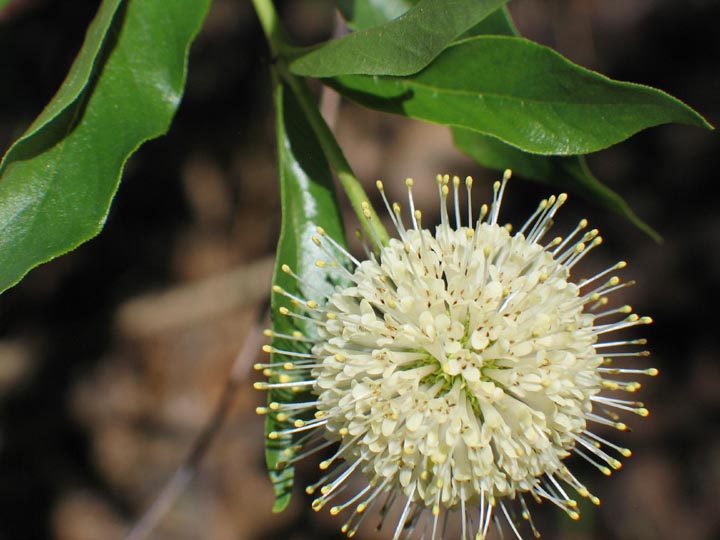
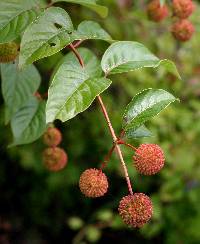
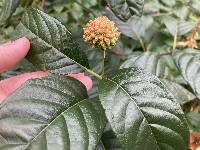

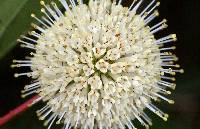
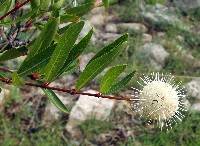
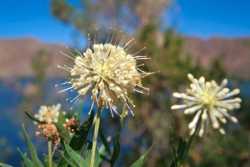
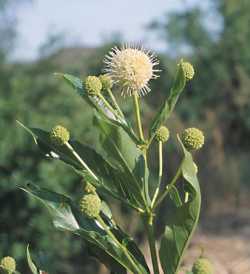
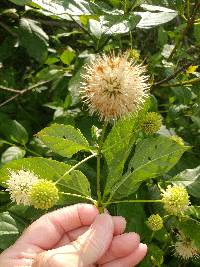
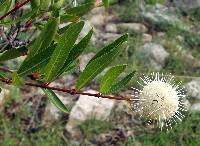
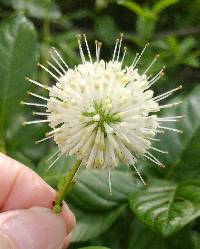
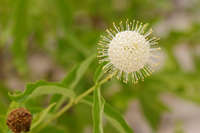
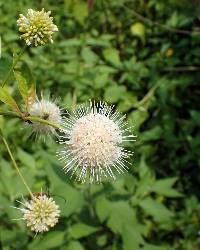
_tn.jpg)
